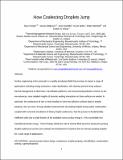| dc.contributor.author | Enright, Ryan | |
| dc.contributor.author | Miljkovic, Nenad | |
| dc.contributor.author | Sprittles, James | |
| dc.contributor.author | Nolan, Kevin | |
| dc.contributor.author | Mitchell, Robert | |
| dc.contributor.author | Wang, Evelyn N. | |
| dc.date.accessioned | 2015-11-23T16:12:34Z | |
| dc.date.available | 2015-11-23T16:12:34Z | |
| dc.date.issued | 2014-09 | |
| dc.date.submitted | 2014-07 | |
| dc.identifier.issn | 1936-0851 | |
| dc.identifier.issn | 1936-086X | |
| dc.identifier.uri | http://hdl.handle.net/1721.1/99996 | |
| dc.description.abstract | Surface engineering at the nanoscale is a rapidly developing field that promises to impact a range of applications including energy production, water desalination, self-cleaning and anti-icing surfaces, thermal management of electronics, microfluidic platforms, and environmental pollution control. As the area advances, more detailed insights of dynamic wetting interactions on these surfaces are needed. In particular, the coalescence of two or more droplets on ultra-low adhesion surfaces leads to droplet jumping. Here we show, through detailed measurements of jumping droplets during water condensation coupled with numerical simulations of binary droplet coalescence, that this process is fundamentally inefficient with only a small fraction of the available excess surface energy (≲6%) convertible into translational kinetic energy. These findings clarify the role of internal fluid dynamics during the jumping droplet coalescence process and underpin the development of systems that can harness jumping droplets for a wide range of applications. | en_US |
| dc.description.sponsorship | Irish Research Council | en_US |
| dc.description.sponsorship | United States. Dept. of Energy. Office of Science (Solid-State Solar-Thermal Energy Conversion Center Award DE-FG02-09ER46577) | en_US |
| dc.description.sponsorship | United States. Office of Naval Research | en_US |
| dc.language.iso | en_US | |
| dc.publisher | American Chemical Society (ACS) | en_US |
| dc.relation.isversionof | http://dx.doi.org/10.1021/nn503643m | en_US |
| dc.rights | Article is made available in accordance with the publisher's policy and may be subject to US copyright law. Please refer to the publisher's site for terms of use. | en_US |
| dc.source | Miljkovic | en_US |
| dc.title | How Coalescing Droplets Jump | en_US |
| dc.type | Article | en_US |
| dc.identifier.citation | Enright, Ryan, Nenad Miljkovic, James Sprittles, Kevin Nolan, Robert Mitchell, and Evelyn N. Wang. “How Coalescing Droplets Jump.” ACS Nano 8, no. 10 (October 28, 2014): 10352–10362. | en_US |
| dc.contributor.department | Massachusetts Institute of Technology. Department of Materials Science and Engineering | en_US |
| dc.contributor.department | Massachusetts Institute of Technology. Department of Mechanical Engineering | en_US |
| dc.contributor.approver | Wang, Evelyn N. | en_US |
| dc.contributor.mitauthor | Enright, Ryan | en_US |
| dc.contributor.mitauthor | Miljkovic, Nenad | en_US |
| dc.contributor.mitauthor | Mitchell, Robert | en_US |
| dc.contributor.mitauthor | Wang, Evelyn N. | en_US |
| dc.relation.journal | ACS Nano | en_US |
| dc.eprint.version | Author's final manuscript | en_US |
| dc.type.uri | http://purl.org/eprint/type/JournalArticle | en_US |
| eprint.status | http://purl.org/eprint/status/PeerReviewed | en_US |
| dspace.orderedauthors | Enright, Ryan; Miljkovic, Nenad; Sprittles, James; Nolan, Kevin; Mitchell, Robert; Wang, Evelyn N. | en_US |
| dc.identifier.orcid | https://orcid.org/0000-0001-7045-1200 | |
| mit.license | PUBLISHER_POLICY | en_US |
| mit.metadata.status | Complete | |
